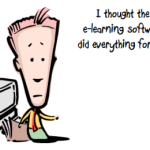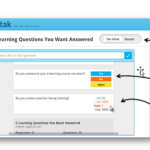I like when they give us ice cream at work.
How to Motivate Adult Learners
September 24th, 2013
I was going to help my son build a computer game using Kodu. I like the app because it’s a simple way to introduce visual programming. I was prepared to sit down with him, watch some tutorials, and then practice. But he was already messing around with the application.
Impressed with what he had done I asked if he had already watched the tutorials. He told me he didn’t know what he was doing. He just started “clicking around” and was figuring it out.
Funny thing about the young ones, they have no problems jumping in and messing around. Adult learners aren’t always so willing to do that. It’s probably because we are so conditioned to avoid failure that it makes us guarded and reluctant to step out a bit.
Assuming you have to work with adult learners, what are some things to consider to keep them motivated and engage? Here are a few quick thoughts:
- Don’t waste time. People don’t like wasting time. The courses they take should be meaningful and relevant to their needs. One of the bad things about elearning is that so many courses forced upon learners are pointless and offer little tangible value. Even if it’s a compliance course, there’s usually a way to frame it in a relevant context. Do that and you’ve taken the first step towards engaging them.
- Account for existing understanding. Adult learners already have experience. Odds are that much of the content in your course the learners already know. Giving them an opportunity to demonstrate what they know is a good practice. Letting learners test out is another way to accommodate their needs.
- Build on what people know. This ties into the point above. Don’t expect that you have to take every person through the course from A to Z. Some people may need that. Others may need to start at Q. So build a course that can assess their current knowledge and let them step in where appropriate.
- Big Brother elearning sucks. Irrelevant compliance training is one thing. But if you are really interested in helping people learn, it may help to turn off the continual monitoring of progress and reporting to the LMS. Create a safe learning environment without tracking every time someone makes a wrong decision.
- Provide practice activities. We are have lots of content and tend to be info-centric. The problem is that content works in tandem with context. So step away from the information dump and focus on how the information is used. Create real-world decision points and ways to access the information required to make good decisions.
- Give meaningful feedback. Decisions produce consequences that are not always black and white. There are lots of nuances to what we do in daily life. Most elearning courses offer simple forms of feedback and sometimes too quickly. Consider how the consequences manifest in the real world and mimic that type of feedback. Sometimes it’s immediate, sometimes it compounds, and sometimes it’s delayed.
- Allow the freedom to function. Adult learners like to look over the content and then assess where they see the value. They also like to move back and forth through the content. However, many courses lock navigation and don’t let people move around. Unlock the navigation and let them choose to learn what they need. Instead of locking the course at the slide level, create decision-making situations where they can prove their understanding and then move on.
- Does it need to be in the LMS? The course you build is a great ongoing resource. But often the course is a take-once event and then locked behind the LMS. Make the course available for future access if it’s really tied to their performance expectations.
- _________________________________ There’s a lot more that can be said about motivating and engaging those who take your online courses. What tips do you have for teaching adult learners?
Events
- Everyday. Check out the weekly training webinars to learn more about Rise, Storyline, and instructional design.
Free E-Learning Resources
 |
 |
 |
|
Want to learn more? Check out these articles and free resources in the community. |
Here’s a great job board for e-learning, instructional design, and training jobs |
Participate in the weekly e-learning challenges to sharpen your skills |
 |
 |
 |
|
Get your free PowerPoint templates and free graphics & stock images. |
Lots of cool e-learning examples to check out and find inspiration. |
Getting Started? This e-learning 101 series and the free e-books will help. |
16 responses to “How to Motivate Adult Learners”
My main thing that I always focus on when working with designing learning for adults goes much in line with your first point. I always make sure I can answer the most important question in the world:
WHY?
If I can’t answer that in a simple and straightforward way something is wrong and I have to re-think and see if I can attack the topic from another angle. Because if I can’t explain it how can I expect others to understand it.
I don’t know how many times it has happened to myself that I have been sitting in a training asking myself: “What am I doing here? What’s the point?”. The reason for this is that the trainer hasn’t been able to explain the WHY.
Tom, this is a great post. It jogged my memory that learners need to expore. Thanks for such great work! Tracie
you nailed it as number one. What’s in it? Why? Who cares? What can I DO with this? That comes in two flavors, best linked. What’s in it for ME? What’s in it for the ORGANIZATION?
Make those cases in a vivid fashion, with stories, data too. Use what you learned in the needs study to show how the program is customized for them.
Useful tips, thanks for publishing.
Jane Hart recently posted a nice article on this topic: http://www.c4lpt.co.uk/blog/2013/09/22/how-do-we-deal-with-unwilling-corporate-learners/#!
She brings up the idea of parsing learners into different levels of self-directedness and designing accordingly.
Great post, and a topic we need to return to over and over. I try to use respectful language but also encourage the learner. You’re right, adults already know lots of stuff, so accounting for existing understanding is a critical component.
I’m a big fan of John Keller’s ARCS motivational model and really try to cycle through it over and over as I’m working out content. You can find descriptions and examples of it online. Great ideas, Tom.
thanks Tom – excellent post.
Good to be reminded of the key points from time to time.
I like the bit about your kid -I’m actually the same – not much of a abc kind of guy – I like to jump in at ‘q’, and I rarely read the manual. For me, its more of a learning experience to tinker and try things out than to be ‘instructed’ – and the rest of your post reinforces how important it is to allow for that.
Thank you so much for your nice article. May be I am mistaking but I perceived 2 scenarios:
1) Formal education or based on a Curriculum
2) Non-formal or Informal education.
Right or wrong I think that the responsibility of any Institution (that provides formal education) that grant a Certificate or Diploma on behalf of a nation is to continuously improve a training program. I am not going to discuss the pedagogical approach (if it is social-constructivism or behaviorist). If the institution has that responsibility due to the trust of the society it is important to continuously thinking if they achieve the learning goals or not or on how to improve them, that is how I think that a Learning Management System (LMS) plays a mayor role. Just to give an example, using a Learning Management System would help us to monitor if the students are using or not any educational material that has been provided. In general to allocate human resources and improve all the processes related with the teaching-learning process
Can you imagine the hypothetical scenario of granting a Medical Doctor certification by any Institution with the trust of the society without having any quality assurance? Will you recommend going to that doctor?
The idea of having a Learning Management System is not to punish a student. It stores information to improve the Teaching -Learning process.
I believe there is no need for a LMS in a non-formal educational program.
Please may you answer . How can you ensure Quality Assurance for a formal education with out using a Learning Management System?
Our rate of dropouts in our e learning courses is less than 10% over the last 6 consecutives years. We promote social activities (like our chocolate contest game) that helps to keep people on board.
There is an article “Application of ISO 9000 standards to education an training” you can find it here.
http://www.cedefop.europa.eu/etv/Upload/Information_resources/Bookshop/124/15-en.html
I would love to know your opinions about it.
Greetings
Carlos
How to Motivate? While, I would agree with all of the points, I am not sure this is really how to motivate an adult learner. It is a list of things to avoid that can quickly demotivate an adult learner. Wasting their time can be an instant turnoff, but I don’t know that not wasting their time would actually motivate them…
Thanks for a great reminder and list of what adult learners tend to need when it comes to eLearning. Don’t treat them like they don’t have a brain and know how to use it.
I think that as a user knowing that you are being considered as intelligent and able to navigate the course material would motivate me to engage w/ the content.
Fan of the ARC model as well.
Thanks Tom for great post!
I read it yesterday evening and couldn’t sleep beacuse was thinking about 3rd bullet (Build on what people know) 🙂 I think it’s one of more important (and forgotten!) thing with ID.
Anyway I was trying to prepare a pre-test which could help learner and I think i did it 🙂
here is my try:
http://tiny.cc/fur03w
If somebody want sources (*.story), can find here:
http://tiny.cc/uwr03w
Hi, Tom:
Thanks for the cogent summary above. For engaging adult learners, I’ve found highlighting misconceptions works. Has a nice element of surprise to it, and helps the learner understand the course may actually be valuable (i.e., builds empathy). I’ll usually work the misconceptions into a few scenarios and sometimes I’ll have traditional questions (select the false statements regarding X)devoted to them.
It does take a bit of work dragging the misconceptions out of the SME (for whom there are no misconceptions), but with some persistence and talking with the main audience of the course, they come out. Thanks again for the post.–Daniel
Gustavo Fring does NOT like online learning apparently.
Tom, your post of course brought me back to Malcolm Knowles and his Adult Learning Theory. I periodically revisit this quote that I came across quite some time ago: “The richest resource for learning resides in adults themselves; therefore, tapping into their experiences through experiential techniques (discussions, simulations, problem-solving activities, or case methods) is beneficial (Brookfield, 1986; Knowles et al., 2005; McKeachie, 2002; Silberman & Auerbach, 1998).”
One of the things I remember (I think!) from his teachings is including/allowing for mistakes, or at least “nonexamples,” during the learning. That’s how your son was learning…through his mistakes…so thumbs up to your point about [not]tracking mistakes.
Translated into Spanish under the Creative Commons 3.0 license: http://redaccioneficaz.es/2013/10/15/como-motivar-a-los-estudiantes-adultos-articulo-tom-kuhlmann/









0
comments